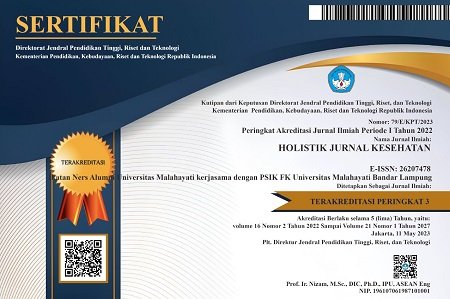Analisis faktor yang berhubungan dengan kejadian diabetes melitus tipe 2
Abstract
Background: Diabetes melitus (DM) is the seventh cause of death in the world. About 90 percent of DM cases are experienced by almost every country and most are classified as type 2 DM. Indonesia ranks seventh with diabetes with a population of 10.7 million. In Lampung Province, Bandar Lampung City is the second highest city for type 2 DM cases after Metro City. Prevalence of type 2 DM at Pertamina Bintang Amin Hospital reach 0.9 percent in 2019, 5.1 percent in 2020 and 6.8 percent in 2020 andoccupying the top 3 positions in outpatient wards. Risk factors Family history of DM, knowledge, nutritional status, physical activity, smoking and fruit and vegetable consumption are closely related to the incidence of type 2 DM.
Purpose: To determine the factors associated with the incidence of type 2 DM in patients with internal medicine polyclinic at Pertamina Bintang Amin Hospital.
Method:This type of research is a quantitative study with a cross sectional approach.The population in this study were all patients at the internal medicine clinic at Pertamina Bintang Amin Hospital. The sampling technique used ispurposive sampling.
Results:The results showed that there was a significant relationship between family history of DM (p-value 0.000), knowledge (p-value 0.000), nutritional status (p-value 0.000), physical activity (p-value 0.000), and the incidence of type 2 DM. There is no significant relationship between fruit and vegetable consumption (p-value 0.186) and smoking (p-value 0.219). The variable with the most dominant influence was family history of DM with OR 21.393, followed by obesity with OR 16.3 on the incidence of type 2 DM at Pertamina Bintang Amin Hospital.
Suggestion: It is recommended for people who have a family history of diabetes sufferers to check their blood sugar levels in order to prevent the occurrence of type 2 DM as early as possible.
Keywords: Diabetes Mellitus Type 2, Factors; Relationships
Pendahuluan: Diabetes melitus (DM) merupakan penyebab kematian ketujuh di dunia. Sekitar 90 persen kasus DM hampir dialami oleh setiap negara dan kebanyakan tergolong DM tipe 2. Indonesia menempati urutan ketujuh penderita diabetes dengan jumlah mencapai 10,7 juta penduduk. Pada provinsi lampung, Kota Bandar Lampung merupakan kota tertinggi kedua kasus DM tipe 2 setelah Kota Metro. Prevalensi DM tipe 2 Di Rumah Sakit Pertamina Bintang Amin mencapai 0,9 persen tahun 2019, 5,1 persen tahun 2020 dan 6,8 persen tahun 2020 dan menduduki posisi 3 teratas di ruang rawat jalan. Faktor risiko Riwayat keluarga DM, pengetahuan, status gizi, aktivitas fisik, merokok dan Konsumsi buah dan sayur erat kaitannya dengan kejadian DM tipe 2.
Tujuan: Mengetahui faktor yang berhubungan dengan kejadian DM tipe 2 pada pasien poliklinik penyakit dalam Rumah Sakit Pertamina Bintang Amin.
Metode: Jenis penelitian ini adalah penelitian kuantitatif dengan pendekatan cross sectional. Populasi dalam penelitian ini adalah seluruh pasien di poliklinik penyakit dalam Rumah Sakit Pertamina Bintang Amin. Teknik sampling yang digunakan adalah purposive sampling.
Hasil: Didapatkan hubungan yang bermakna antara riwayat DM Pada keluarga (p-value 0,000), pengetahuan (p-value 0,000), Status Gizi (p-value 0,000), aktivitas fisik (p-value 0,000), dengan kejadian DM tipe 2. Tidak ada hubungan yang bermakna antara Konsumsi Buah dan Sayur (p-value 0,186) dan merokok (p-value 0,219). Variabel yang paling dominan pengaruhnya adalah riwayat DM pada keluarga dengan OR 21,393 disusul oleh obesitas dengan OR 16,3 terhadap kejadian DM tipe 2 di Rumah Sakit Pertamina Bintang Amin.
Saran: Disarankan bagi masyarakat yang memiliki riwayat keluarga penderita diabetes hendaknya memeriksakan kadar gula darahnya agar dapat melakukan pencegahan sedini mungkin terhadap kejadian DM tipe 2.
Keywords
References
American Diabetes Association. (2020). 2. Classification and diagnosis of diabetes: standards of medical care in diabetes—2020. Diabetes care, 43(Supplement_1), S14-S31.
Centers for Disease Control and Prevention. (2017). Diabetes 2017 Report Card. Diakses dari: https://www.cdc.gov/diabetes/pdfs/library/diabetesreportcard2017-508.pdf
Chairunnisa, W. R. (2020). Faktor Risiko Diabetes Melitus Tipe II di Wilayah Kerja Puskesmas Glugur Darat Kota Medan Tahun 2020. Fakultas Kesehatan Masyarakat Universitas Islam Negeri Sumatera Utara. http://repository. uinsu. ac. id/11347/1/Wan Rizky ChaiIrunnisa-Repository. pdf.
Fauzi, Y., & Sari, F. M. (2022). Hubungan Pengetahuan dan Obesitas dengan Kejadian Diabetes Mellitus di Puskesmas Lingkar Timur Kota Bengkulu. Jurnal Inovasi Kesehatan, 3(2), 81-85.
Heryana, A. (2020). Buku Ajar Metodologi Penelitian pada Kesehatan Masyarakat. Bahan Ajar Keperawatan Gigi, June, 1–187.
Isnaini, N., & Ratnasari, R. (2018). Faktor risiko mempengaruhi kejadian Diabetes mellitus tipe dua. Jurnal Kebidanan Dan Keperawatan Aisyiyah, 14(1), 59–68. https://doi.org/10.31101/jkk.550.
Kementerian Kesehatan Republik Indonesia. (2019). Laporan_Nasional_RKD2018_FINAL.pdf. In Badan Penelitian dan Pengembangan Kesehatan (p. 198). Diakses dari: https://protc.id/wp-content/uploads/2021/07/Laporan_Nasional_RKD2018_FINAL.pdf
Khalish, N., & Hansen, H. (2021). Literatur Review Hubungan IMT dengan Kadar Gula pada Penderita Diabetes Mellitus Tipe 2. Borneo Studies and Research, 2(3), 1987-1995.
Kunaryanti, K., Andriyani, A., & Wulandari, R. (2018). Hubungan Tingkat Pengetahuan Tentang Diabetes Mellitus Dengan Perilaku Mengontrol Gula Darah Pada Pasien Diabetes Mellitus Rawat Jalan Di Rsud Dr. Moewardi Surakarta. Jurnal Kesehatan, 11(1), 49–55. https://doi.org/10.23917/jk.v11i1.7007.
Latifah, N., & Nugroho, P. S. (2020). Hubungan Stres Dan Merokok Dengan Kejadian Diabetes Melitus Di Wilayah Kerja Puskesmas Palaran Kota Samarinda Tahun 2019. Borneo Studies and Research, 1(2), 1243-1248.
Mamluk, L., O'Doherty, M. G., Orfanos, P., Saitakis, G., Woodside, J. V., Liao, L. M., & Kee, F. (2017). Fruit and vegetable intake and risk of incident of type 2 diabetes: results from the consortium on health and ageing network of cohorts in Europe and the United States (CHANCES). European journal of clinical nutrition, 71(1), 83-91.
Murti, B. (2019). Perlukah menghitung ukuran sampel?. Jurnal Kedokteran YARSI, 15(1). DOI:10.33476/jky.v15i1.1009.
Ogurtsova, K., Guariguata, L., Barengo, N. C., Ruiz, P. L. D., Sacre, J. W., Karuranga, S., Sun, H., Boyko, E. J., & Magliano, D. J. (2022). IDF diabetes Atlas: Global estimates of undiagnosed diabetes in adults for 2021. Diabetes Research and Clinical Practice, 183. https://doi.org/10.1016/j.diabres.2021.109118
Puteri, H. E. (2020). Menentukan Populasi dan Sampel. Riset Ekonomi Dan Perbankan Islam, April, 2. https://doi.org/10.13140/RG.2.2.28776.01285.
Rofikoh, R., Handayani, S., Suraya, I. (2020). Determinan Kejadian Diabetes Melitus Tipe 2 di Posbindu Mawar Kuning Gambir. ARKESMAS (Arsip Kesehatan Masyarakat), 5(1), 42–48. https://doi. org/10.22236 /arkesmas. v5i1.3847
Rumah Sakit Pertamina Bintang Amin. (2022). Data rekam medis Rumah Sakit Pertamina Bintang Amin.
Wang, B., Liu, K., Mi, M., & Wang, J. (2014). Effect of fruit juice on glucose control and insulin sensitivity in adults: a meta-analysis of 12 randomized controlled trials. PLoS One, 9(4), e95323.
World Health Organization. (2019). Classification of diabetes mellitus. In Clinics in Laboratory Medicine (Vol. 21, Issue 1). https://doi .org/10.5005/jp/books/12855_84.
World Health Organization. (2020). Insulin and associated devices: access for everybody. World Health Organization, September, 1–24. http://apps.who.int/bookorders.
Xi, B., Li, S., Liu, Z., Tian, H., Yin, X., Huai, P., & Steffen, L. M. (2014). Intake of fruit juice and incidence of type 2 diabetes: a systematic review and meta-analysis. PloS one, 9(3), e93471.
DOI: https://doi.org/10.33024/hjk.v17i4.11190
Refbacks
- There are currently no refbacks.
Copyright (c) 2023 Holistik Jurnal Kesehatan

This work is licensed under a Creative Commons Attribution-NonCommercial 4.0 International License.














